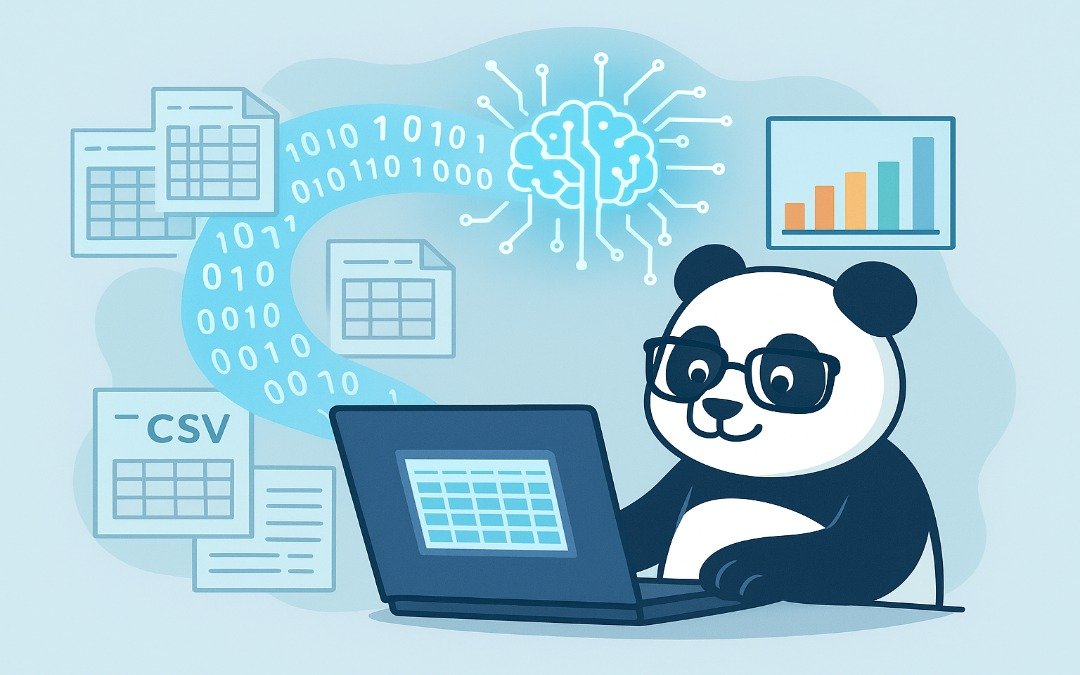How to use a Local AI Model to Analyze Large CSV file with Pandas
Analyzing massive CSV files with AI usually means uploading sensitive data to the cloud, but what if you could do it all locally?
In this guide, we tackle a common challenge: how to analyze large CSV files using local large language models (LLMs). While cloud-based AI tools are powerful, they often compromise privacy, control, and cost. Local LLMs keep your data on your machine, but they come with limitations, especially when dealing with large datasets that exceed the model’s context window.
That’s where PandasAI comes in. It bridges the gap by intelligently breaking down and querying large CSV files, allowing you to interact with your data using natural language, all without sending a single byte to the cloud.
This step-by-step guide will show you how to combine PandasAI with a local LLM (like qwen2.5-coder) for fast, secure, and smart CSV analysis.
Why Use AI Models on Your Own Computer?
Cloud-based AI tools are easy to use and often very powerful. But they also have some downsides: your data is sent to remote servers, you can’t change much about how the model works, and using them can get expensive.
Local AI models run on your own computer, so they avoid many of these issues.
What’s Good About Local Models:
- Privacy: Your data stays on your device. Nothing gets uploaded.
- More Control: You can choose which model to use and adjust how it works.
- Works Offline: You don’t need an internet connection to use it.
What’s Not So Great:
- Needs Good Hardware: Big models can be slow or won’t run well without a fast computer and enough memory.
- Takes Time to Set Up: You’ll need to install some tools and set things up yourself.
- Not Always as Smart: Local models are getting better, but they’re still not as advanced as some online ones.
What is PandasAI?
PandasAI is an open-source Python library that enhances the Pandas DataFrame with AI-driven features. It allows users to interact with their data using natural language queries, which are then translated into executable Python code by a large language model (LLM). This integration enables users to perform data analysis tasks without writing explicit code, making data exploration more intuitive and accessible.
How Does PandasAI Generate Code?
When you pose a question to a DataFrame using PandasAI, the library:
- Interprets the Query: Your natural language input is parsed to understand the intent and context.
- Generates Python Code: An LLM generates Python code that performs the requested data manipulation or analysis.
- Executes the Code: The generated code is executed within the Python environment.
- Returns the Result: The output is presented in a user-friendly format, such as a DataFrame, chart, or summary.
By combining PandasAI with a local LLM, you can keep your data private while still using AI to automate and accelerate your data analysis.
Getting Started
What You will need:
- You need Python 3.8–3.12 installed on your machine.
- Pandas the foundational data analysis library.
- PandasAI for AI-enhanced interactions.
- A local LLM server such as Ollama.
- A local model: e.g.,
qwen2.5-coder,deepseek-coder, or similar.
Step-by-Step:
1. Install Required Libraries:
2. Install and Run Your Local LLM:
-
Install Ollama or your preferred local model manager.
-
Pull a model:
ollama pull qwen2.5-coder:32b - Start the model server:
ollama serve3. Set Up PandasAI to Use Local LLM: In your Python script:
from langchain_ollama import ChatOllama
from pandasai import SmartDataframe
import pandas as pdllm = ChatOllama(model=”qwen2.5-coder:32b”)
df = pd.read_csv(“your_large_file.csv”)
sdf = SmartDataframe(df, config={“llm”: llm})
response = sdf.chat(“I need a detailed analysis of this data.”)
print(response)4. Start Analyzing Your CSV Files Locally!
You can ask complex questions, generate summaries, create visualizations, and transform data, all without sending anything to the cloud.
My Findings
After working with PandasAI and a local LLM (qwen2.5-coder), here’s what I found:
- Large CSV files: When files are too large to fit into the model’s context window, PandasAI’s snippet system works surprisingly well for managing and analyzing the data in smaller pieces.
- Data analysis and chart generation: Both worked smoothly with the local LLM. I used qwen2.5-coder and found it handled most tasks effectively.
- Consistency: I tested with various CSV files, and the analysis was consistently accurate. I believe setting the LLM’s temperature to
0helped reduce randomness in responses. - Minor charting issues: Occasionally, chart labels (especially long texts) would get cut off or overflow from the image area.
- Special characters in data: If the CSV contained special characters (such as error messages from logs), the code generation sometimes struggled. This might be due to differences between qwen2.5-coder and larger cloud-based models like OpenAI’s GPT.
Final Thoughts
For developers or teams working with sensitive data or very large datasets, this approach offers a practical way to unlock the power of AI without relying on cloud services. It’s a great example of how local AI tools are becoming strong enough to handle real-world data analysis tasks.
If you’re comfortable setting up a local LLM and managing a few limitations, PandasAI combined with a local model can transform how you work with CSV files.
Author: Viktor Vörös





